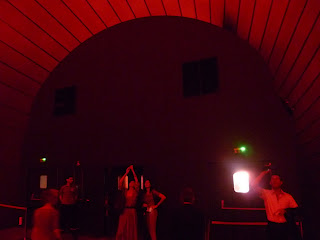I visited Anish Kapoor's installation, titled Leviathan, for the Grand Palais' Monumenta exhibit, where a different artist each year is invited to contribute a temporary installation. Rather than analyze the piece, I'll just supplement the photos with a report on what it was like to be there.
From the outside, the Grand Palais is an broad wedding-cake from the late 1800s wrapped around a huge iron-and-glass roof (sorry I don't have a photo of the roof from the outside).
Through the lobby was a dark wall with revolving door, its windows tinted red.
The revolving door practically threw me into this:
The surface was a double-layer, deep red fabric that allowed just enough light through to make everything inside monochromatic. The shadows from the glass roof frame fell across the curved surface. When I touched the fabric skin, there was a bit of give, but it was under a high degree of tension from being inflated inside like a giant balloon.
Enormous "tunnels" gave off from the central space where I and other visitors were; I couldn't really see the end of those tunnels, so I didn't know for how far they extended. For that matter, I had some difficulty gauging how large the space was from the inside.
The acoustics were strange, as loud noises made inside (people occasionally whistled or clapped to test it out) echoed back from unexpected directions and at odd intervals. Also, I sometimes barely caught the sound of people on the other side of the fabric.
The air inside was quite warm.
Here's the wall with the revolving door (behind the woman raising her hands to take a photo), with the large square vents above inflating Leviathan with warm air.
Leaving the way I came in, I passed through another door into la Nef (the Nave), the main hall of the Grand Palais, to view from the outside what I had just been inside. Suffice it to say that it is awe-inspiringly massive.

The large bulges around the sides are the "tunnels" whose depths I couldn't perceive from the inside.
And of course, the Grand Palais itself is a pretty amazing structure.
































No comments:
Post a Comment